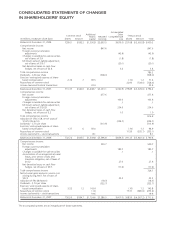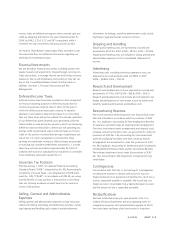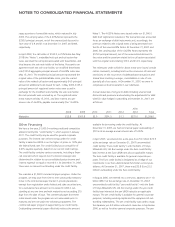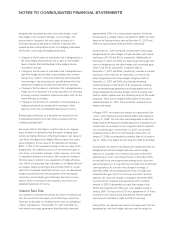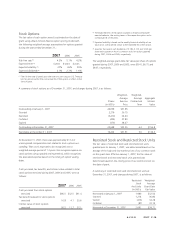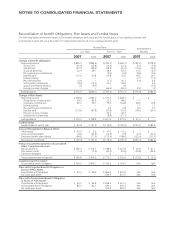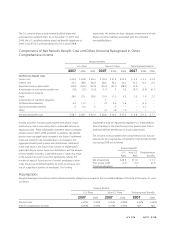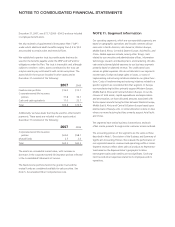Avon 2007 Annual Report Download - page 68
Download and view the complete annual report
Please find page 68 of the 2007 Avon annual report below. You can navigate through the pages in the report by either clicking on the pages listed below, or by using the keyword search tool below to find specific information within the annual report.NOTES TO CONSOLIDATED FINANCIAL STATEMENTS
designate the instrument as either a fair value hedge, a cash
flow hedge, a net investment hedge, or a non-hedge. The
accounting for changes in fair value (gains or losses) of a
derivative instrument depends on whether it has been des-
ignated by Avon and qualifies as part of a hedging relationship
and further, on the type of hedging relationship.
• Changes in the fair value of a derivative that is designated as a
fair value hedge, along with the loss or gain on the hedged
asset or liability that is attributable to the hedged risk are
recorded in earnings.
• Changes in the fair value of a derivative that is designated as a
cash flow hedge are recorded in accumulated other compre-
hensive loss (“AOCI”) to the extent effective and reclassified
into earnings in the same period or periods during which the
transaction hedged by that derivative also affects earnings.
• Changes in the fair value of a derivative that is designated as a
hedge of a net investment in a foreign operation are recorded
in foreign currency translation adjustments within AOCI to the
extent effective as a hedge.
• Changes in the fair value of a derivative not designated as a
hedging instrument are recognized in earnings in other
expense, net on the Consolidated Statements of Income.
Realized gains and losses on a derivative are reported on the
Consolidated Statements of Cash Flows consistent with the
underlying hedged item.
We assess, both at the hedge’s inception and on an ongoing
basis, whether the derivatives that are used in hedging trans-
actions are highly effective in offsetting changes in fair values or
cash flows of hedged items. Highly effective means that cumu-
lative changes in the fair value of the derivative are between
80% – 125% of the cumulative changes in the fair value of the
hedged item. The ineffective portion of the derivative’s gain or
loss, if any, is recorded in earnings in other expense, net on the
Consolidated Statements of Income. We include the change in
the time value of options in our assessment of hedge effective-
ness. When we determine that a derivative is not highly effective
as a hedge, hedge accounting is discontinued. When it is prob-
able that a forecasted transaction will not occur, we discontinue
hedge accounting for the affected portion of the forecasted
transaction, and reclassify gains and losses that were accumu-
lated in AOCI to earnings in other expense, net on the Con-
solidated Statements of Income.
Interest Rate Risk
Our long-term, fixed-rate borrowings are subject to interest rate
risk. We use interest rate swaps, which effectively convert the
fixed rate on the debt to a floating interest rate, to manage our
interest rate exposure. At December 31, 2007 and 2006, we
held interest rate swap agreements that effectively converted
approximately 30% of our outstanding long-term, fixed-rate
borrowings to a variable interest rate based on LIBOR. Our total
exposure to floating interest rates at December 31, 2007 and
2006 was approximately 60% and 50%, respectively.
At December 31, 2007 and 2006, we had interest rate swaps
designated as fair value hedges of fixed-rate debt, with unreal-
ized losses of $10.8 and $23.9, respectively. Additionally, at
December 31, 2007 and 2006, we had interest rate swaps that
were not designated as fair value hedges with unrealized gains
of $9.7 and $13.8, respectively. Long-term debt at
December 31, 2007 and 2006, respectively, includes net unreal-
ized losses of $9.4 and $21.8, respectively, on interest rate
swaps designated as fair value hedges. Long-term debt at
December 31, 2007 and 2006, also includes remaining
unamortized gains of $8.4 and $12.8, respectively, resulting
from terminated swap agreements and swap agreements no
longer designated as fair value hedges, which are being amor-
tized to interest expense over the remaining terms of the under-
lying debt. There was no hedge ineffectiveness for the years
ended December 31, 2007, 2006 and 2005, related to these
interest rate swaps.
In August 2007, we entered into treasury lock agreements (the
“locks”) with notional amounts totaling $500.0 that expired on
January 31, 2008. The locks have been designated as cash flow
hedges and are being used to hedge exposure to a possible rise in
interest rates, as we expect to incur long-term debt to refinance
our commercial paper. At December 31, 2007, we recorded
unrealized losses of $25.3 in AOCI related to these locks. On
January 31, 2008, we extended the maturity date of the locks to
July 31, 2008, as we expect to incur long-term debt by that date.
During 2005, we entered into treasury lock agreements that we
designated as cash flow hedges and were used to hedge
exposure to a possible rise in interest rates prior to the antici-
pated issuance of ten- and 30-year bonds. In December 2005,
we decided that a more appropriate strategy was to issue five-
year bonds given our strong cash flow and high level of cash and
cash equivalents. As a result of the change in strategy, in
December 2005, we de-designated the locks as hedges and
reclassified the gain of $2.5 on the locks from AOCI to other
expense, net. Upon the change in strategy in December 2005,
we entered into a treasury lock agreement with a notional
amount of $250.0 designated as a cash flow hedge of the
$500.0 principal amount of five-year notes payable issued in
January 2006. The loss on the 2005 lock agreement of $1.9 was
recorded in AOCI and is being amortized to interest expense
over five years (see Note 4, Debt and Other Financing).
During 2003, we entered into treasury lock agreements that we
designated as cash flow hedges and were used to hedge the


